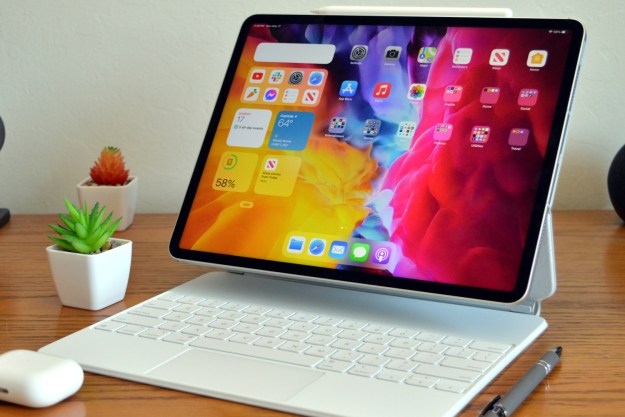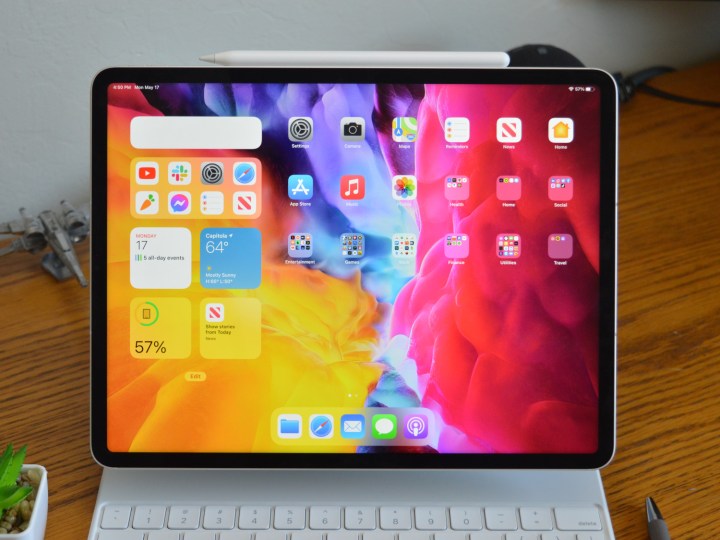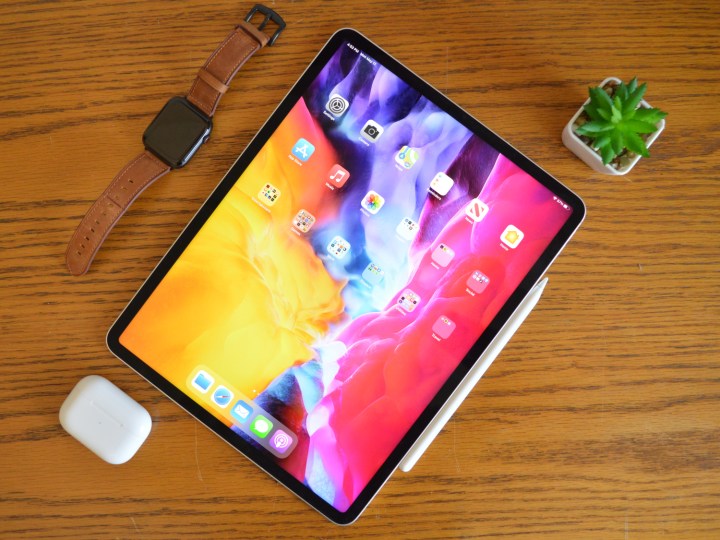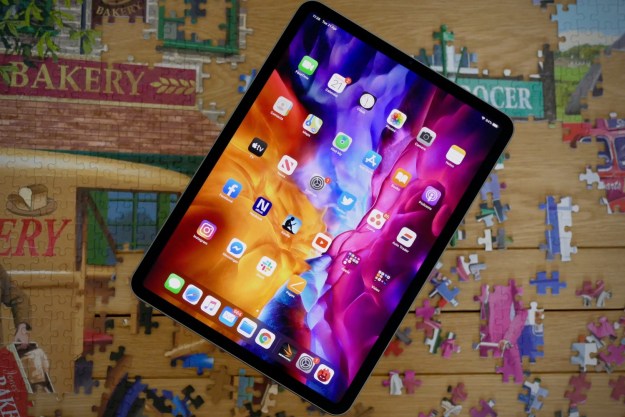
“The iPad Pro takes the previous-generation iPad, and gives it meaningful updates that will make what was already the best tablet even better.”
- Incredible performance
- Beautiful display on 12.9-inch model
- Stunning design
- Center Stage works great
- USB 4/Thunderbolt 3 port
- Nearly MacBook priced
- No Mini-LED on 11-inch model
For the past year or so, the iPad Pro has been in a transition period. Prior to that, it was a relatively clear choice for those who wanted a modern, powerful iPad. Then came the new iPad Air, an almost-as-good option at a much lower price. Now, Apple wants to raise the iPad Pro bar — and to that end, has given it the same highly praised and incredibly powerful chip found in the new Mac Mini and MacBook Air.
There are other upgrades in the new iPad Pro, though none perhaps as headline-grabbing. Notably, the 12.9-inch iPad Pro finally gets the long-rumored Mini-LED “Liquid Retina XDR” display. Then there’s 5G support, and the USB 4 port.
But does all of this add up to an iPad Pro that’s truly worth spending the extra money for over the iPad Air?
Hardware and design
At first glance, the iPad Pro is identical to the previous-generation tablet. That’s not a bad thing — it’s still the best-looking, most modern tablet out there. You won’t get the fun colors of the iPad Air, but Apple’s “pro” devices usually don’t anyway. Instead, the device comes in space gray or silver, and we’re reviewing the latter.
For the uninitiated, the iPad Pro has an edge-to-edge display, with bezels that are just big enough to be able to hold the tablet without accidentally touching the display. It’s also got flat edges, like the new iPhone 12 series, and a dual camera module on the back. It’s a great look.
It comes in two sizes — an 11-inch model, and a 12.9-inch model. This year, unfortunately, there are some differences in features between the two sizes, which we’ll get into a little later.

There are some ways in which Apple could have changed the design. For starters, the front-facing camera is still on the top edge. I regularly used the iPad in portrait orientation, but I never video-chatted that way — and as a result, I definitely would have preferred the front-facing camera to be located in the right edge. Frankly, I don’t see why Apple can’t include a camera on both edges. That would also help make Face ID a little more seamless, as it’s not uncommon to accidentally cover up Face ID sensors when using the device horizontally.
As someone who’s used to the 11-inch size, the 12.9-inch device that we’re reviewing definitely felt oversized initially, but I got used to it — and for some tasks, preferred it.
For the most part, however, the iPad Pro is still a stunning tablet, and it feels great in the hand. As someone who’s used to the 11-inch size, the 12.9-inch device that we’re reviewing definitely felt oversized initially, but I got used to it — and for some tasks, preferred it. Ultimately, I’ll probably stick with the smaller device for personal use, but I get the appeal of the big one, especially if you tend to use your device for watching movies and playing games a lot.
New for 2021 is the fact that the iPad Pro now has a USB 4 port, which includes support for Thunderbolt 3. That opens up its usage to a much wider range of accessories, and could help the device be better integrated into creative workflows, like with audio interfaces.

I’ll briefly go over Apple’s Magic Keyboard here. For 2021, you can get it in white — and Apple recommends buying a new one if you’re going for the 12.9-inch model. According to the company, the extra 0.5mm thickness can impact the Magic Keyboard properly closing. That’s super annoying, especially considering how expensive the Magic Keyboard is in the first place. But this accessory is still awesome — it makes it easy to remove and place the iPad, the keys and trackpad feel great, and so on.
I am slightly concerned about the white color, though. After only using the device for a week, there’s no real discoloration or scuff-marks on the white keyboard, but it’s pretty easy to imagine those appearing over time. Call me boring, but I still prefer the black option.
Specs and performance
While the design remains unchanged, under the hood the iPad Pro is an all-new tablet. Gone is the mobile-focused A-series processor, in favor of a laptop-class M1 chip — the same chip found in the new MacBook Air, Mac Mini, iMac, and 13-inch MacBook Pro. That’s coupled with either 8GB or 16GB of RAM, depending on your configuration — and that’s the most RAM ever found in an iPad.
The results aren’t surprising, though. The 2021 iPad Pro performs like a beast. It’s able to handle even more intense mobile gaming with ease, and it’s more than capable of editing a video in iMovie — thought I’m not much of a video editor, so some may beg to differ.

The fact that the iPad Pro is such a performer is a good thing, of course. But the previous-generation iPad Pro was already an incredibly high-performing tablet, and the increased performance of the M1 doesn’t really enable more features — at least not yet. My previous-generation iPad Pro still performs as well as the day I got it, even under heavy multitasking and mobile gaming.
Of course, this could change in the future — and I hope it does. I would love to really put the M1 chip in the iPad Pro through its paces. Some will be able to do so, using apps like Adobe Premiere Rush, which may be able to leverage more of the power under the hood. But it would be nice if a larger number of people could do so, and that will require a much more desktop-like approach to iPadOS. Hopefully, we’ll get some updates to iPadOS at Apple’s Worldwide Developers Conference (WWDC) in June.
The previous-generation iPad Pro was already an incredibly high-performing tablet, and the increased performance of the M1 doesn’t really enable more features — at least not yet.
In the meantime, even if you don’t need all the processing power on offer by the iPad Pro, it is easily the way to go if you want the most powerful iPad you can get. And the fact that it’s so powerful will hopefully also have an impact on longevity, allowing the device to perform well for longer than other iPad models already perform.
The 2021 iPad Pro also supports 5G, which is nice to see. For the right people, it will help a lot, and in brief testing, it worked well.
Liquid Retina XDR Mini-LED display
Processing power in the iPad Pro is one thing that may not have an impact on day-to-day use for most people, considering how well the iPad Pro already performed. But the other major update to the iPad Pro is in the display — and that has the potential to impact everyone who uses it.
The 2021 iPad Pro offers a Liquid Retina XDR display, with a 264 pixel-per-inch density and a 120Hz refresh rate. But what does Liquid Retina XDR mean? Well, for the first time on an iPad, you’ll get a Mini-LED display. Now, to understand why that’s important, it helps to understand some basics about display technology. OLED displays are able to illuminate individual pixels, meaning that they can turn off pixels when there’s black in an image on the display — making for much deeper black levels. LED displays can’t do this, since LED displays require a backlight. But instead of a single backlight, or a few dozen “zones” (the previous-generation iPad Pro offered 72), Mini-LED displays offer thousands. In the iPad Pro, the 10,000 miniaturized LEDs are grouped into 2,500 local dimming zones, which Apple claims should allow the iPad Pro to show deep blacks right next to bright colors.
There’s a catch, though — this tech is only available on the larger 12.9-inch iPad Pro, and not the 11-inch model. That’s a little frustrating, especially as someone who prefers the smaller iPad size in the first place.

If you don’t mind buying the larger iPad Pro, though, you’ll notice a difference — the display on the 12.9-inch iPad Pro is beautiful. Black levels are indeed deeper and more natural, and colors are able to get much more vibrant and bright, especially when it comes to HDR content. Speaking of HDR content, the new device is able to deliver a peak brightness of a massive 1,600 nits during HDR viewing — and you can tell. Next to the previous-generation display, there is a clear difference.
Now, that doesn’t necessarily mean that you should care about the better display — especially for the price. Most people will indeed be able to tell the difference between this display and a previous-generation one, but unless you rely on an accurate, bright display for your job, it’s worth waiting until the tech bleeds down to cheaper iPad models. The previous iPad Pro, as well as the new 11-inch iPad Pro, still have an awesome display, and one that’s more than capable of displaying movies and your photos in stunning detail.
Cameras
Camera technology has been upgraded on the new iPad Pro too, and in ways that could be legitimately helpful. The rear-facing cameras on the iPad Pro have not changed — you’ll get the same 12-megapixel main camera and 10-megapixel ultrawide camera, and they’re able to take solid photos with enough detail for most situations.
On the front, however, there are some updates. Notably, the front-facing camera has been updated from the 7-megapixel sensor on the last generation to a new 12-megapixel ultrawide camera. That’s not so your colleagues or family can see more of your messy home, though — it’s for Center Stage.

Center Stage essentially uses the front-facing camera on the iPad Pro to follow you around a room. It does this by cropping the image in to you, and then using face recognition to move that crop around what the sensor sees as you move. Of course, there are limits to how far you can move before the camera isn’t capable of seeing you any more, but in my experience, the 120-degree field of view makes for a system that is actually quite helpful.
Even better is the fact that the tech works for any application using the front-facing camera — without developers having to tweak anything. That means that whether you use first-party apps, like FaceTime, or third-party options like Zoom or Microsoft Teams, Center Stage will work by default. If you don’t want Center Stage in a particular app, you can disable it in Settings on an app-by-app basis.
Software
On the iPad Pro, you’ll get Apple’s iPadOS, which has so far stuck pretty close to iOS. There have been some updates, like improved multitasking, but in general, if you’ve used an iPhone, you’ve pretty much used an iPad.
That hasn’t been a huge deal so far — after all, iPadOS is still a far better experience than using Android on a tablet. But given the addition of the M1 chip, and the fact that Apple has long attempted to position the iPad as a laptop replacement, it may be time for an upgrade to the operating system. I would love to see updates like options for app windowing, better external display support, and perhaps even support for Mac apps, given the fact that those apps can now run on the ARM architecture anyway.

It would be nice if Apple itself finally released pro apps to the iPad, too. Apps like Final Cut Pro and Logic Pro on the iPad would truly allow users to take advantage of that processing power. There are third-party alternatives, like Luma Fusion, but Apple’s own apps are popular for a reason.
It’s possible that we’ll hear more about iPadOS at the upcoming WWDC, and if we don’t, rest assured that iPadOS still offers the best tablet software experience out there. But I can’t help but think it could do more.
Our take
The iPad Pro takes the previous-generation iPad, and gives it meaningful updates that will make what was already the best tablet even better. The M1 chip makes the new iPad Pro easily the most powerful tablet out there, the Liquid Retina XDR tech creates a stunningly beautiful dispaly, and tweaks like the addition of Center Stage aren’t just gimmicks — they’re actually quite helpful.
Is there a better alternative?
There is no tablet better than the 2021 iPad Pro, but there certainly might be one that’s more appropriate for you. This is not the tablet for most people — it’s the tablet for those that either have plenty of cash to burn, or want something for their actual job. If you’re looking for something for multimedia consumption, gaming, and just general use, the 2020 iPad Air is the way to go. You’ll still get the modern design, excellent performance, and more. Alternatively, the entry-level 10.2-inch iPad is still available, and while it doesn’t offer the same modern design, it’s more than enough iPad for watching videos, browsing the web, and using social media.
There are Android tablet options, but unless you’re really set on sticking within Google’s ecosystem, it’s worth avoiding them and going for an iPad instead. If you want the Android equivalent of the iPad Pro, the Samsung Galaxy Tab S7+ is probably the device for you. Alternatively, it may be worth looking at a Surface Pro if you want a full desktop operating system and like Windows.
How long will it last?
The 2021 iPad Pro should last more than a few years, as long as you take care of it. The device is not water-resistant, and as you would expect, the front of the device is glass — so it will likely break if you drop it.
But as long as the device isn’t physically harmed, I think it should last five years or more, depending on how processor-intensive iPadOS gets. The M1 chip ensures that the device is more or less future-proof for at least a few years, plus Apple’s stellar track-record when it comes to software updates means that you should continue getting iPadOS updates for quite some time.
Should you buy it?
Yes, but only if you really want or need the biggest and best tablet. The 2021 iPad Pro is more than enough iPad for most people. A lot more. But if spending more than $800 on a tablet isn’t really a big deal for you, you’ll absolutely love the 2021 iPad Pro.
Editors' Recommendations
- Best iPad deals: Save on iPad Air, iPad Pro, iPad Mini for the New Year
- Apple’s new iPad Pro and iPad Air just got delayed
- You may have to wait a while longer for new iPads
- This is when Apple will finally release its new 2024 iPads
- Apple’s new iPad Pro may not be as expensive as we feared


